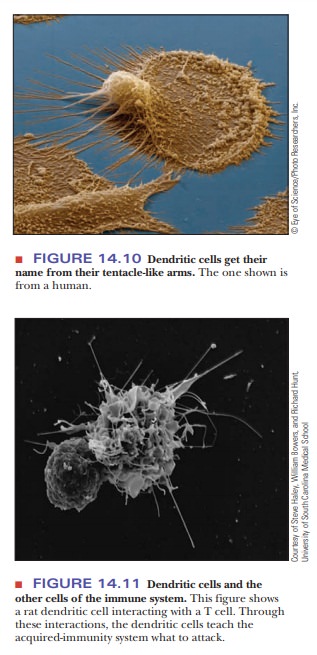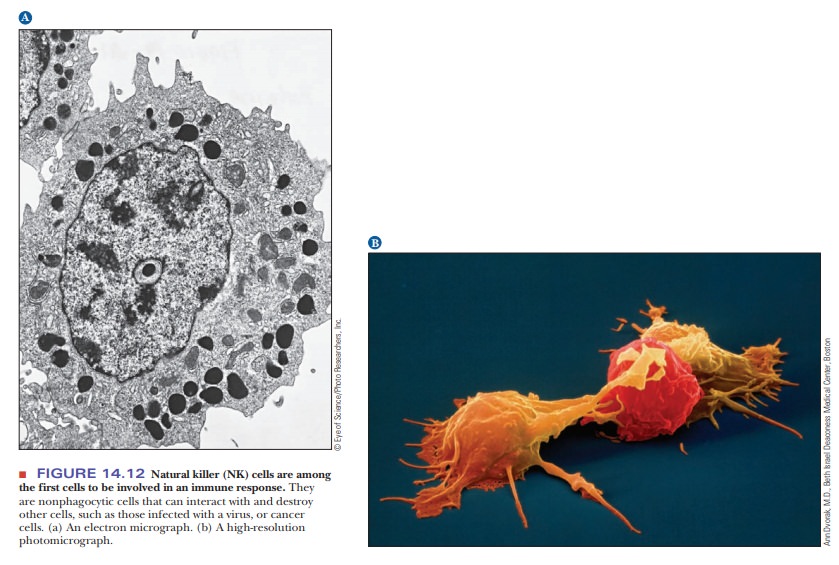Chapter: Biochemistry: Viruses, Cancer, and Immunology
Innate Immunity-The Front Lines of Defense

Innate Immunity-The Front Lines
of Defense
When one considers the tremendous numbers of bacteria, viruses,
parasites, and toxins that our bodies have to deal with, it is a wonder that we
are not continually sick. Most students learn about antibodies in high school,
and these days everyone learns about T cells, because of their relationship to
AIDS. However, there are many more weapons of immune defense than T cells and
antibodies. In reality, you discover that you are sick only after a pathogen
has managed to beat your front-line defense, which is called innate immunity.
Innate immunity has several parts. One part includes physical
barriers, such as skin, mucus, and tears. All of these hinder penetration by
pathogens and do not require specialized cells to fight the pathogen. However,
if a pathogen, be it a bacterium, virus, or parasite, breaches this outer layer
of defense, the cellular warriors of the innate system come into play. The
cells of the innate immune system that we will discuss are dendritic cells, macrophages, and natural killer(NK) cells. One of the first and most important cells
to join the fight are thedendritic cells, so called because of their dendrites,
which are long, tentacle-like projections (see Figure 14.10). Dendritic cells
are found in the skin, the mucous membranes, the lungs, and the spleen, and are
the first cells of the innate system to have a crack at any virus or bacterium
that wanders across their path. Using suction-cup-like receptors, they grab
onto invaders and then engulf them by endocytosis. These cells then chop up the
devoured pathogens and bring parts of their proteins to the surface. Here the
protein fragments are displayed on a protein called a major histocompatibility complex (MHC). The dendritic cells travel
through the lymph to the spleen, where they present these antigens to other
cells of the immune system, the helper T
cells (TH cells). Dendritic cells are
members of a class of cells referred to as antigen-presentingcells
(APCs), and they are the starting point in most of the responses that are
tra-ditionally associated with the immune system. Once the dendritic cells
present

Besides their basic role in presenting antigens to T cells and B
cells, den-dritic cells have recently been very popular with companies that are
trying to generate antibodies to help fight cancer. Dendritic cells do have a
downside, however. It was recently found that HIV uses a receptor on dendritic
cells to hitch a ride in the lymph system until it can find a TH cell.
Some labs are working on chemicals to block this interaction in the hopes of
slowing down HIV’s travel through the body.
Another important cell type in the innate immunity system is the naturalkiller (NK) cell (Figure 14.12), which is a member of a class of leukocytescalled lymphocytes, because it is derived from a type of stem cell called a lymphoid stem cell. NK cells kill off cells that have been infected by viruses or that are cancerous, and they secrete cytokines that call up other cells, such as macrophages, another innate-immunity cell type that destroys microbes.

They also work with dendritic cells, in a sense. If an infection is small, the NK cells may end up killing off the infected dendritic cells before the rest of the immune system is activated. Thus, NK cells help decide whether the acquired-immunity system needs to be activated. NK cells are also important in fighting cancer. They are stimulated by interferon, an antiviral glycoprotein, which was employed as one of the first treatments for cancer and the first protein to be cloned and expressed for human use. Macrophages and other cells of the innate immune system have unfortunately also been identified as some of the big players in cancer, where they are a type of double-edged sword. Their presence can be a direct attack against cancer cells, but they also lead to inflammation, which has been shown to promote the progression of cancerous cells from a premalignant state to full proliferation.
Related Topics